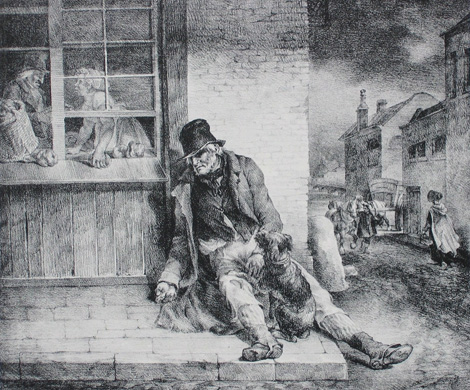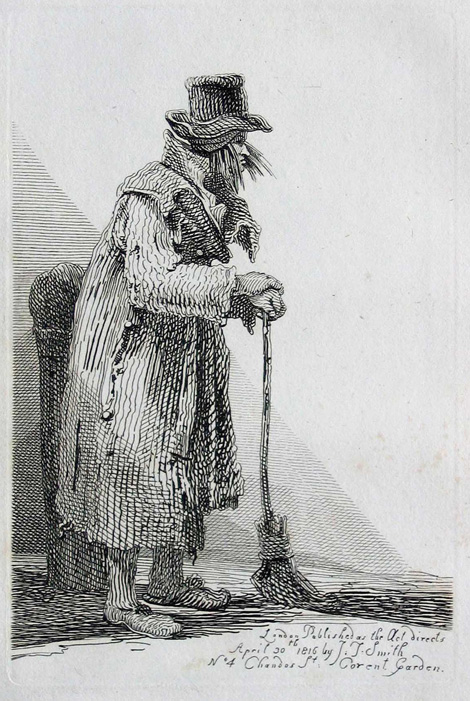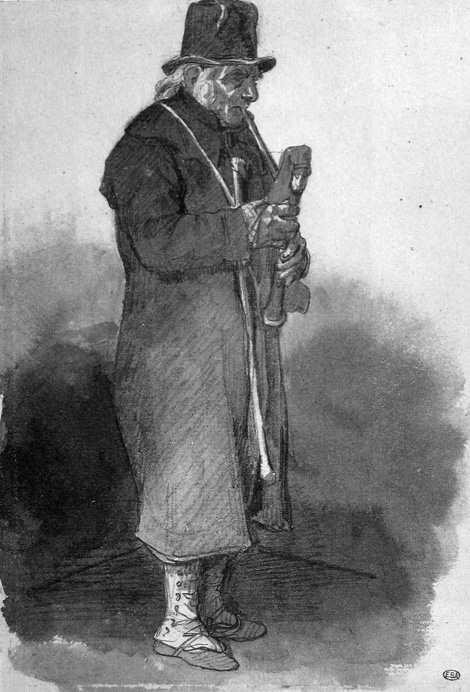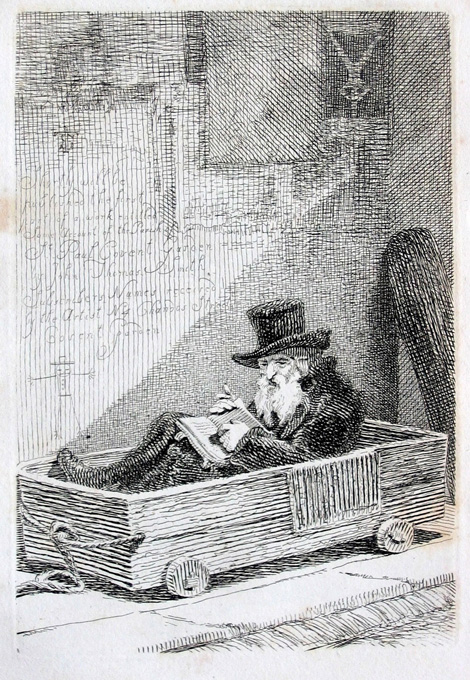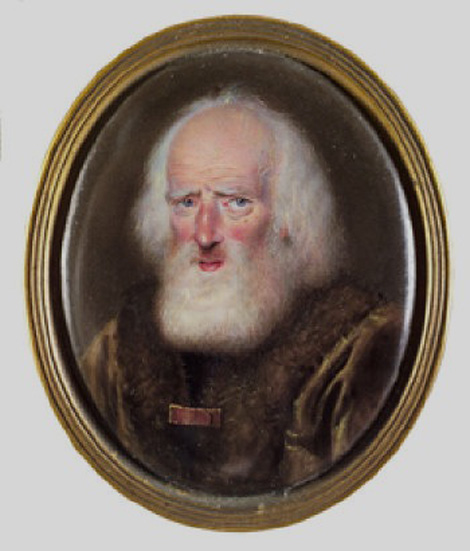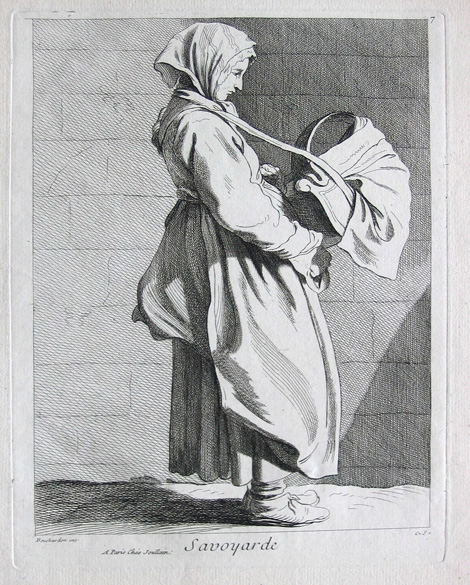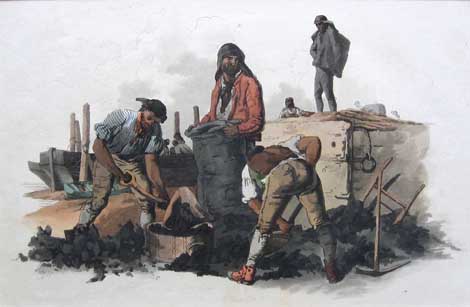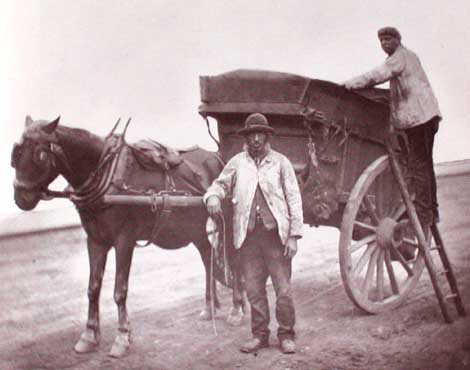Alexander Roob]
[April 1, 2015
John Thomas Smith and the Invention of Investigative Social Reportage III: The Cries of London
Abriged version. For footnotes please see the more detailed German version.
5) The Cries of London
In Great Britain, the years after Waterloo were characterised by a deep economic depression. Big cities were flooded by jobless persons, war invalids and discharged soldiers. While visiting London in 1820, Théodore Gericault captured the descending social misery in an impressive series of lithographic drawings. His portfolio, Various Subjects Drawn From Life and on Stone, marked the start of a whole array of French documentations of the poor English conditions.
Théodore Géricault, Pity the Sorrows of a Poor Old Man, in: Various Subjects Drawn From Life and on Stone, London 1821
J.T. Smith, Daniel Cropp, in: Vagabondiana, London 1817 (MePri-Coll.)
Théodore Géricault, Le Joueur de cornemuse (The Piper), London ca. 1820 (Ecole nationale superieure des Beaux-Arts, Paris)
The bourgeoisie felt increasingly pestered by the exploding army of beggars and pedlars. A royal commission of inquiry was appointed to remedy this, and in 1815 published a first Mendicity and Vagrancy Report. Further investigations followed. Between 1816 and 1820, four independently operating commissions scrutinised the efficiency of the existing Poor Laws. For publishers, the issuing of these kinds of reports was a lucrative business. The commission’s recommendations resulted in countering the problem of homelessness and beggary with strict police measures. These measures were so drastic that in 1822 the worried republican essayist Charles Lamb raised the question of where the “parting Genius of Beggary” had been disposed of, whether the army of the poor had been shot or dropped into the Thames. The fear that the London vagabondage could be a fading cultural asset had already prompted John Thomas Smith a few years earlier to accompany the work of the first commission with a visual documentation seeking to preserve for posterity the activities of pedlars and beggars. The work was published in 1817 under the baroque title of Vagabondiana or Anecdotes of Mendicant Wanderers through the Streets of London.
Vagabondiana did not mark a departure from but a continuation of Smith’s archaeological preservation work. When looking through his topographic works, one can easily retrace how the human figure was increasingly placed in the focus of his artistic attention. Already in Antient Topography of London, vagrants the size of tin soldiers roam through the historical decor to then become bloated and space-filling in Vagabondiana. The Goyaesque impression gained when viewing the depictions that are set and illuminated like on a stage is not on account of a direct influence. One can almost rule out that Smith was familiar with the etchings of Francisco de Goya. The basic feature of horror and grotesqueness combined with a residuum of social-realistic harshness characteristic of the art of both Goya and Smith can perhaps be explained by a large overlapping of common artistic models, above all Giovanni Battista Piranesi and William Hogarth.
J.T.Smith, A Jewish Mendicant, in: Vagabondiana, London 1817 (MePri-Coll.)
J.T.Smith, John Mac Nally, in: Vagabondiana, London 1817 (MePri-Coll.)
Francisco Goya, Yo lo he visto en Paris, 1824-28
Francisco Goya, Trabajos de la guerra, 1808-12
J.T.Smith, William Kinlock, a blind ex-service man, in: Vagabondiana, London 1817 (MePri-Coll.)
Smith admired William Hogarth for his “active eye [that] caught nature in all her garbs”, and made his aesthetic demand for greatest possible diversity the guiding principle of his own work and teachings. In the context of the genesis of illustrated reportage, William Hogarth plays a pivotal role. With his accounts of contemporary realities of life referencing daily issues, he provided a foundation for British art in the field of visual journalism and political cartooning. Hogarth was also the first artist to depict the work of the parliamentary investigation committees. In the painting Bambridge on Trial for Murder by a Committee of the House of Commons from 1729, he describes the crucial phase of the investigation of the allegations of torture made against the corrupt director of the Fleet prison. The painting was realised as a graphic print by Thomas Cook in 1803.
William Hogarth: Bambridge on Trial for Murder by a Committee of the House of Commons. (1729) Kupferstich von Thomas Cook, London 1803 (MePri-Coll.)
In Aristotelian aesthetics, the description of daily life had already been attributed to the lowest literary genre of comedy. In both his social depiction and earlier landscapes, Smith aimed at this low level of the burlesque, at the plebeian dregs, and as with the Remarks on Rural Scenery, he introduced his pictures of the jobless, beggars and vagrants with a text meant to ground the field of depicting poverty in art-historical terms. With the northern French engraver Jacques Callot, Smith took the probably most influential figure of European printed graphics after Dürer to the witness stand to defend the lowest genre level, the dirty art of rhyparography. According to Smith, the twenty-five depictions of beggars and highwaymen that Callot had etched with great empathy during the deprivations of the Thirty Years’ War in Lorraine were evidently drawn after nature. The sequence of etchings are among Callot’s most widely dispersed, inspiring Rembrandt, an avid collector of his graphics, to numerous works of his own. Smith presents twenty-three graphic prints by Rembrandt known to him that depict beggars. With Jan Miel and Jan Dirkz Both, he additionally mentions two proponents of Bambocciade, a Dutch clique of artists engaged in the description of social misery at the same time as Callot.
Jacques Callot, Etching from the series: The complete Beggars (Les Gueux), 1622/ 23 (MePri-Coll.)
Francois Vivares after Rembrandt: Beggar, ca. 1740 (MePri-Coll.)
The numerous art-historical references presented by Smith leave no doubt that the character of the beggar was a canonical motif. Charles Lamb had stylised the beggar to the “only free man in the universe” and set off his trade from the faceless and ahistorical misery of the industrial labour force as “the oldest on honourables form of pauperism” due to its ancient origin. As if they were stylites, certain beggars not seldom enjoyed a legendary status qualifying them to be portrayed like popular outlaws and spectacular murderers. Smith gives the example of a well-known miniature painting by the Irish artist Nathaniel Hone showing the detailed portrait of the age-old beggar James Turner.
Nathaniel Hone, Portrait of James Turner, a Beggar, 1750 (National Gallery of Ireland, Dublin)
The Scottish barber and caricaturist John Kay made a further extraordinarily empathetic portrait of a beggar in 1805 – the 109-year-old John Steele. Kay, like Smith who was twelve years younger, was an untiring graphic social chronicler.
John Kay, John Steele, Beggar at the advanced age of 109 years, drawn from life, Edinburgh 1805 (ed.1842) (MePri-Coll.)
The pictorial tradition in which Smith developed his pauperism reportages was an early form of genre depiction and, as with any genre, it was tied to a very essential feature that Smith, however, was to undermine in his work – the anonymity of the depicted persons. It was the tradition of the so-called cries, (French: cris) series of pictures in which since the late 16th century the activities of street sellers and migrant workers omnipresent in the cityscape were depicted in a standardised form.
Annibale Carracci / Simon Guillain, Le arti di Bologna, ed. Rome 1646
Young Annibale Carracci gave this medieval tradition of social depiction a new direction with a series of drawings of craftsmen and street vendors in Bologna which he had made in 1595. His Arti di Bologna was a sort of model book used in the teachings of the Accademia degli Incamminati, the private school of the Carracci brothers, to practise the depiction of lively and natural characters.
The workshop of the Carracci’s was known for “everything under creation” being drawn there in a cross-genre fashion. The opulent crossover is reflected in the disparate, anti-classicist oeuvre of Annibale that with ribald genre paintings, caricatures, nature studies, as well as social and event graphics already reveals all facets of illustrated journalism. Two decades before Callot’s beggar depictions, Annibale’s Bolognese craftsmen studies had initiated an exciting turn in social graphics towards a true-to-life, individualised rendering of characters. Smith held the series in high esteem on account of its mimetic qualities, its “real characters”.
In England, in was above all the cries series of the French-Dutch artist Marcellus Lauron, who had been living in London since the 1620s, that was style-forming. Lauron’s typology influenced all subsequent English cries. The characters he established can be found in Hogarth’s street scenes, and William Blake was also evidently inspired by a Lauron model in an illustration of his poem London, sheet 69, The London Begger, in which a homeless mother with a child at her hand wanders through the picture
Marcellus Lauron, The London Begger, in: Cryes of London (Pl. 69) London 1687
William Blake, Jerusalem The Emanation of the Giant Albion, London 1804-20 (Pl. 84, Detail)
Paris could look back on the longest tradition of street vendor depictions, originating in the late 15th century. In 1737 two of the most seminal Cris de Paris cycles were published independently of each other: a version by Francois Boucher and the first instalment of a five-part series by the early classicist sculptor and graphic artist Edmé de Bouchardon. Both independently built upon the prior achievements of Annibale Carracci and the Cris adaptations by the artists of the Callot school. The realistic studies of Savoyard migrant workers in Paris that Antoine Watteau created at the beginning of the century were a further, important source of inspiration.
Jean-Antonine Watteau, The old Savoyard, ca. 1715 (The Art Institute of Chicago)
Comte de Caylus, Petit savoyard, d’après Antoine Watteau, ca. 1720 (MePri-Coll.)
Bouchardon lent proud self-confidence to his vendors and labourers, which was egregious at the time. In historical retrospect, it is hard not to detect an harbinger of the emerging sansculottic spirit of rebellion in this heroic glorification of the canaille. It was engraved by an amateur, the Comte de Caylus, with the assistance of a professional engraver. The count was one of the colourful figures of contemporary French cultural life and in view of his diverse activities just as hard to grasp as John Thomas Smith. The well-known art patron counted as the actual initiator of this cries project. In the studies of antiquities, he had made a name for himself as a leading expert on ancient Greece. What Smith and Caylus had in common, though, was not limited to the interplay of archaeological and socio-historical interests. Caylus was also an untiring experimenter in the field of graphic prints. Moreover, he diligently passed on anecdotes, fairy tales and stories, and was the author of numerous artist biographies. Smith was most probably familiar with the cycles of Bouchardon and Caylus. The work circulated internationally and had an influence on French genre painting that cannot be underestimated.
Edme Bouchardon / Comte de Caylus, Garcon Boulanger, in: Études prises dans le bas peuple ou Les Cris de Paris, Paris 1737 – 1746 (MePri-Coll.)
Edme Bouchardon / Comte de Caylus, Savoyarde, in: Études prises dans le bas peuple ou Les Cris de Paris, Paris 1737 – 1746 (MePri-Coll.)
However, the series with its idealised conception of characters was also an indicator of a crisis of this traditional typology, which could be aligned less and less with the actually existing social conditions. When a few years later Paul Sandby took up the theme in a series of twelve etchings and a series of gouaches, he did so in a rarely found sarcastic manner. By confronting the social idyll of Lauron’s 17th-century typology with the altered realities on the streets of London, he quite blatantly expressed social tensions.
Paul Sandby, Rare Mackerel, c. 1759 (Nottingham Castle, Nottingham)
So at the point in time when Smith endeavoured to capture the activities of street sellers and beggars for posterity, it was clear that he could only approach this genre by thoroughly revising it. Shorty beforehand, his artist friend and critic William Henry Pyne had provided an example showing the possibilities offered by the expansion and updating of an has-been historical genre to describe the reality of everyday life. In 1804 Pyne had published a folio with sixty hand-coloured aquatint prints presenting a social-realistic panorama of contemporary labour conditions in England. The series quite obviously had a considerable impact on the social graphics of Théodore Gericault, on his London series and his subsequent depictions of similar themes in France. Pyne had developed his broadly conceived reportage of the British world of work in the historical format of a costume book. This genre allowed him to represent a broad social structure ranging from the dustman to the member of parliament – beyond estates-based ranks of order in the form of an egalitarian juxtaposition.
William Henry Pyne, Coal Heavers, in: Costumes of Great Britain, London 1804. (Lithography, handcoloured) (MePri-Coll.)
William Henry Pyne: Dustmen, in: Costumes of Great Britain, London 1804 (Lithography, handcoloured) (MePri-Coll.)
Théodore Géricault, Les Boueux (The dustmen), Paris 1823
John Thomson, Flying Dustmen, in: Street – Life in London. London 1876
